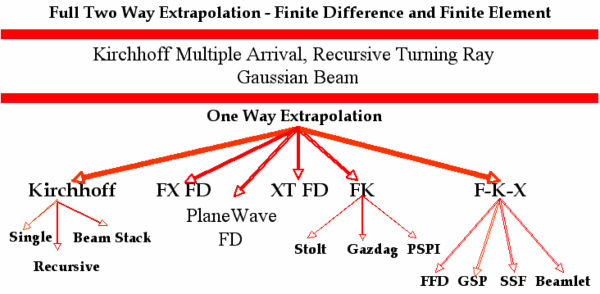Computational Complexity
The hierarchy of algorithms in Figure 1 makes us wonder why this diagram has so many different one-way approaches. Why are there so many one-way methods and so few two-way or almost two-way technologies?
The simple answer is that the demarcation between one-way and two-way methods is one of computational efficiency. That is, one-way methods tend to be significantly more computationally efficient than two-way methods. This statement is certainly a function of algorithm implementation, but it is not a bad rule of thumb. Rumors have it that the Gaussian beam method can be made extremely efficient, and so the rule may be broken in that case. However, because all of the one-way methods function depth slice by depth slice or time slice by time slice, two-way approaches that must compute the entire wavefield at each propagation step usually lose the efficiency battle.
In spite of the apparent complexity of Figure 1, there are really only three basic algorithm styles. The first group might be best referred to as raytrace methods, and includes all of the Kirchhoff methods and the Gaussian beam. The second group generally includes methods that image depth slice by depth slice using either finite differences or some form of Fourier domain method. At the top of the hierarchy, the third group does imaging volume by volume. Thus, the computational complexity increases greatly as we move from the bottom to the top in Figure 1.
From a more practical viewpoint, raytrace-based methods are by far the most flexible. They can output data anywhere at any desired volumetric level. At some loss of overall accuracy, they can be made far more efficient than any other approach. In the slice-by-slice world, common azimuth methods rule the day. As we move up the accuracy chain, one-way shot profile methods are more efficient than two-way approaches. There is no question that as the computational complexity increases, efficiency decreases, but accuracy improves dramatically.

